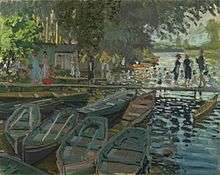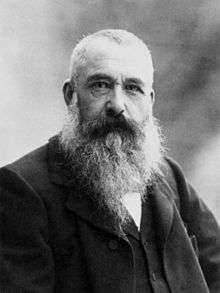Bain à la Grenouillère
| La Grenouillère | |
|---|---|
| Bain à la Grenouillère | |
 | |
| Artist |
Claude Monet |
| Year | 1869 |
| Medium | Oil on canvas |
| Dimensions | 74.6 cm (29.4 in) × 99.7 cm (39.3 in) |
| Location | Metropolitan Museum of Art |
| Identifiers | The Met object ID: 437135 |
Bain à la Grenouillère is a painting by the impressionist painter, Claude Monet. (Oil on canvas, 74.6 cm x 99.7 cm)
History
Monet wrote on September 25, 1869 in a letter to Frédéric Bazille, "I do have a dream, a painting (tableau), the baths of La Grenouillère, for which I have made some bad sketches (pochades), but it is only a dream.[1] Pierre-Auguste Renoir, who has just spent two months here, also wants to do this painting." Monet and Renoir, both desperately poor, were quite close at the time.[2]

The painting here and one in the London National Gallery (Bathers at La Grenouillere, oil on canvas, 73 x 92 cm) are probably the sketches mentioned by Monet in his letter. A bigger size painting, now lost but formerly in the Arnhold collection in Berlin, may well have been the "tableau" that he dreamed of.[3] The broad, constructive brushstrokes here are clearly those of a sketch. For his exhibition pictures Monet usually sought a more delicate and carefully calibrated surface at this time. An almost identical composition of the same subject by Renoir is in the Nationalmuseum, Stockholm. The two friends were undoubtedly working side by side.
La Grenouillère was a popular middle-class resort consisting of a spa, a boating establishment and a floating café. Optimistically promoted as "Trouville-sur-Seine", it was located on the Seine near Bougival, easily accessible by train from Paris and had just been favoured with a visit by Emperor Napoleon III with his wife and son. Monet and Renoir both recognized in La Grenouillère an ideal subject for the images of leisure they hoped to sell.
Description
As in his earlier picture of the Garden at Sainte-Adresse, Monet concentrated on repetitive elements – the ripples on the water, the foliage, the boats, the human figures – to weave a fabric of brushstrokes which, although emphatically brushstrokes, retain a strong descriptive quality.
Provenance
The painting is now in the New York Metropolitan Museum of Art. It was bequeathed by Mrs. H. O. Havemeyer in 1929.
References
- ↑ Daniel Wildenstein, Claude Monet. Biographie et catalogue raisonné. Lausanne, Paris, La Bibliothèque des Arts, Fondation Wildenstein, p. 135.
- ↑ Danielle Pastor Lloret: "Vers de nouveaux horizons." pp. 225-238, in Libres horizons: pour une approche comparatiste, lettres francophones imaginaires : hommage à Arlette et Roger Chemain, Micéala Symington, Béatrice Bonhomme, Editions L'Harmattan, 2008, ISBN 2296049745
- ↑ Wilson, M., Wyld, M., Roy, A. ‘Monet’s Bathers at La Grenouillère‘. National Gallery Technical Bulletin Vol 5, p. 14.
Further reading
- Bomford D, Kirby J, Leighton, J., Roy A. Art in the Making: Impressionism. National Gallery Publications, London, 1990, pp. 120–125.
External links
- Impressionism: a centenary exhibition, an exhibition catalog from The Metropolitan Museum of Art (fully available online as PDF), which contains material on this painting (145-149)
- Claude Monet, Bathing at La Grenouillère, ColourLex. Contains information on all paintings by Monet and Renoir painted in La Grenouillère and also a pigment analysis of the painting in the National Gallery in London.
| Wikimedia Commons has media related to Claude Monet. |
